The narrator of a story is the voice that tells it. Unlike the author, who exists outside the world of the text, the narrator shapes the reader’s experience, guiding tone, style, and what is revealed or concealed. Some narrators may seem trustworthy and objective; others may mislead the reader, either intentionally or due to their own limited knowledge.
In this article, we’ll explore key types of narrators — from omniscient to unreliable — and help you choose one that best suits your story.
Here's a sneak-peak of what we'll cover: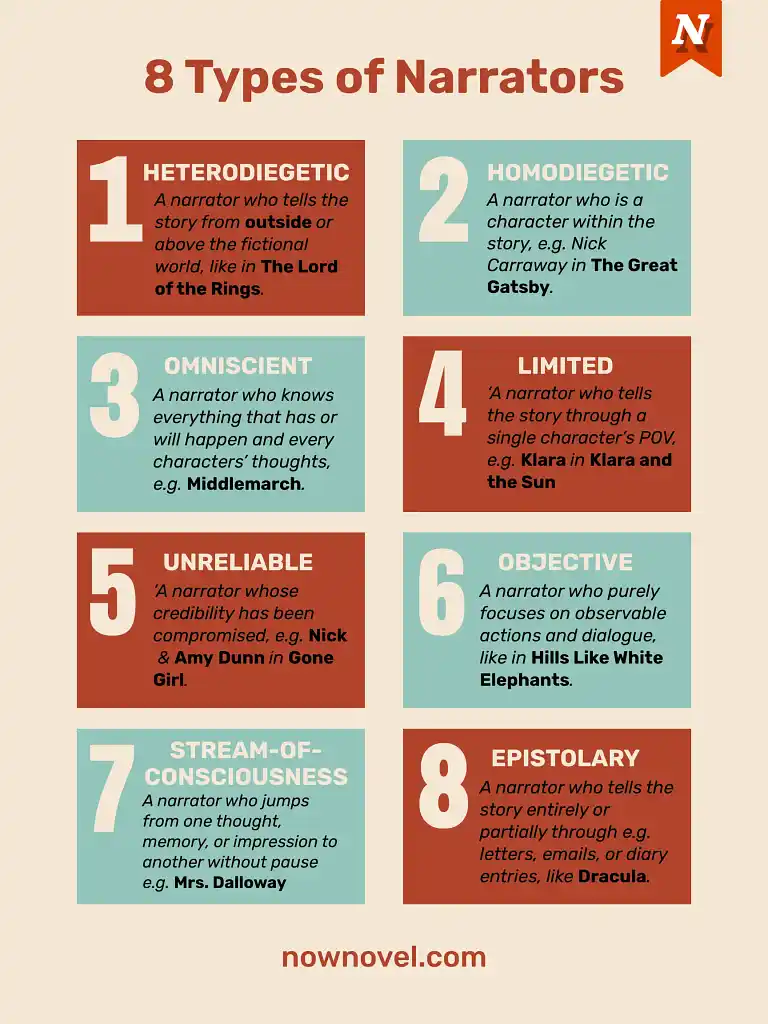
Let’s start by considering where your narrator stands in relation to your story.
☝️Note that this article does not cover first, second, or third person POV. If you’d like a refresher on those, check out this guide to POV.
Heterodiegetic narrators
A heterodiegetic narrator is the technical term for a narrator who tells the story from outside the fictional world they describe — think hetero as in “other” or “different.” They do not participate in the events but relay the narrative to the reader, offering a bird’s-eye view of the story. This perspective can either focus on a single character or reveal the inner lives of multiple characters, providing insight into their thoughts, emotions, and actions.
A classic example is the narrator in J.R.R. Tolkien’s The Lord of the Rings, who tells the story from outside Middle-earth. Even as they zoom into characters’ thoughts and describe battles or landscapes in rich detail, they never actually participate in or affect the narrative arc. Similarly, the narrator in Jane Austen’s Pride and Prejudice shapes our impressions of Elizabeth and Darcy but does not interfere with any of the action.
Why use a heterodiegetic narrator?
Heterodiegetic narrators are ideal for epic, historical, or complex stories where multiple perspectives are necessary, or where you want the reader to be able to focus on the plot without being concerned with the narrator’s potential bias. They can also create dramatic irony, showing readers more than the characters know. This style works well for stories where objectivity and broad perspective are key, but it still allows for a distinctive narrative voice.
In The Night Circus by Erin Morgenstern, for example, the heterodiegetic narrator gives the story a dreamy, almost fable-like tone that keeps the reader intrigued:
The circus arrives without warning. No announcements precede it. It is simply there, when yesterday it was not.
Homodiegetic narrators
In contrast, a homodiegetic narrator is a character within the story who experiences and affects the events — think homo as in “same.” These narrators offer an intimate look into the story world through their perspective, often recalling past events or discovering new ones alongside the reader. They may or may not be reliable as their personal involvement makes the narration more subjective.
A classic example of a homodiegetic narrator is Nick Carraway in The Great Gatsby, who tells the story as someone who’s witnessed the enigmatic Jay Gatsby’s rise and fall up close. Another example is Scout Finch in To Kill a Mockingbird, who narrates her childhood experiences with an adult’s reflective voice.
For a more modern example, take Katniss Everdeen in The Hunger Games. The reader experiences everything through her eyes, and as she gains a broader understanding of her nation, Panem (especially its dazzling yet sinister capital), so does the reader.
Why use a homodiegetic narrator?
Homodiegetic narrators can create a sense of intimacy and immediacy. Since they have a will and mind of their own, they can also add some fun complexity to the story, introducing unreliability and biases (more on this later). This is especially effective in character-driven stories where the emotional depth and personal growth of the narrator are central.
🌿 If you want to get even more into the weeds of diegetic narrators, check out this blog post for a break down some of the more intricate terms of narration, like “intradiagetic” and “extradiegetic.”
Other types of narrators tend to fall either into the hetero- or homodiegetic category, so let’s take a look at some major types that you will encounter all throughout literature.
Omniscient narrators
An omniscient narrator knows everything — from the actions of all the characters to their innermost thoughts, and what goes on in the far reaches of the realm. Heterodiegetic narrators are usually omniscient, and omniscient narrators are usually (but not always) heterodiegetic, existing outside the narrative and providing an “all-seeing” perspective on events.
Contradictory as it might seem, some omniscient narrators are known as limited omniscient narrators — or selective omniscient narrators. This restricts the narrator’s knowledge to just a few key characters, whereas traditional omniscience provides a broader view of the story world.
The narrator in George Eliot’s Middlemarch is an example of a traditional omniscient narrator who knows the innermost thoughts and motivations of every character, even those far removed from the main narrative. Here, the narrator captures a main character’s emotional state:
Dorothea’s heart was full of a strange, tremulous sweetness, as if the best thing in life were about to happen to her, and yet she had no clue what that best thing was.
Later on, the narrator also gives the reader access to Mr. Casaubon’s thoughts — the man who marries Dorothea because he needs an assistant for his research — revealing his internal conflict and motivations:
Mr. Casaubon’s mind was like a haunted house, with nothing but ghosts of ideas that he had once cherished; and now he felt as if his life had been a succession of futile inquiries.
Meanwhile, in A Game of Thrones by George R.R. Martin, the narrative is technically omniscient (since it reveals what happens in different parts of the world and what multiple characters are thinking), but it’s limited in the sense that each chapter focuses on a particular character’s POV. We get their perspective, but only theirs, even though the narrator could technically jump to anyone or anywhere.
Realistically speaking, most omniscient narrators end up being limited because while the narrator may know what everyone is thinking, not all of it will be relevant to the story. So, authors tend to focus on a few characters to avoid so-called “head-hopping.”
Why use omniscient narrators?
This style is ideal for stories with multiple characters, settings, or time periods. The omniscient narrator can provide essential context and create dramatic irony, revealing information to the reader that’s unknown to the characters, or allowing for a neutral portrayal of their motivations. This is particularly helpful in stories with complex moral or thematic elements, where authors can use the omniscient narrator style to portray a theme or topic from multiple perspectives.
Limited narrators
A limited narrator tells the story through a single character’s eyes, filtering it through their thoughts, experiences, and knowledge. The narrator can be either first-person or third-person; in first-person, the limitation is clear: the narrator can only speak to their own experiences. In third-person, the narrator is more flexible but still bound to one character’s perspective, filtering all events through their eyes.
Klara and the Sun by Kazuo Ishiguro, for instance, is narrated by Klara, an “Artificial Friend” who has been purchased to accompany a young girl, Josie. Klara only knows the world based on her own experiences and configurations. She can reflect and guess what other people are thinking and feeling, but ultimately never knows for sure. Like when Klara tries to understand how Josie is feeling about the disappearance of her friend, Rick:
As the days continued and there was still no visit from Rick, Josie grew more quiet, and her signals became keep away ones.
Why use limited narrators?
This style creates a close bond between the character and the reader. It’s particularly useful when you want to build tension around what the character does or doesn’t know and when their internal biases shape the narrative. The reader won’t know what’s objectively true, what other people are thinking or doing, or what is going to happen next, which makes for a compelling reading experience.
Unreliable narrators
An unreliable narrator is a storyteller whose credibility has been compromised. This can happen for various reasons: they might be deliberately deceptive, mentally unstable, or simply unaware of key facts. This narration style is closely tied together with limited narrators and can make readers question the validity of the narrator’s account as they have to actively interpret the gaps, contradictions, and omissions, piecing together the real story from what is being presented.
In Edgar Allen Poe’s "The Tell-Tale Heart," the narrator insists on their sanity while simultaneously recounting the murder they’ve committed in a delirious, guilt-ridden monologue. Readers immediately sense the narrator’s madness, even though they are vehemently denying it, and this contradiction creates tension in the story, exploring both guilt and paranoia.
Likewise, in Gone Girl by Gillian Flynn, both Nick and Amy Dunne serve as unreliable narrators, each presenting a version of their troubled marriage that is colored by their personal biases, lies, and manipulations. This creates an unpredictable narrative, where readers are constantly second-guessing what is real and what is fabrication — and whose side to take.
Why use unreliable narrators?
One of the biggest advantages of an unreliable narrator is the sense of suspense and surprise it can generate. Since readers can't trust the narrator's version of events, they become invested in uncovering the truth. This style is particularly great for genres like thriller or horror.
On the flip side, if the deception is too obvious, or if there are too few hints about the narrator’s unreliability, the twist may fall flat. Similarly, the narrator’s unreliability has to feel justified; otherwise, it can feel like a gimmick rather than an organic part of the story.
Objective narrators
An objective narrator presents the events of the story without delving into any specific character's thoughts or emotions. This type of narration focuses purely on observable actions and dialogue and is often referred to as a "camera-eye" perspective.
In "The Lottery" by Shirley Jackson, for instance, the narrator describes the characters' actions, their dialogue, and their responses to a ritualistic lottery without delving into their inner thoughts. This builds suspense as the reader is left to wonder about the true nature of the lottery and the people involved. The shocking twist at the end is all the more jarring because the objective narration has kept us distant from the characters’ emotions and motives throughout.
Similarly, Ernest Hemingway uses an objective narrator in his short story, "Hills Like White Elephants." The story takes place in a bar in Spain, where a man and a woman discuss whether or not to have an abortion. The narrator gives no insight into their inner thoughts, only describing their actions and dialogue. The absence of emotional commentary forces the reader to interpret the subtext of their conversation and draw conclusions about their relationship and the decisions they face.
Why use objective narrators?
The objective narrator offers a detached, neutral view of events and doesn’t insert any opinions, allowing readers to form their own judgments based on what they can observe on the page. This can be particularly useful when you want to address themes of alienation or deal with morally ambiguous topics without taking a direct stance.
But while this perspective can leave room for interpretation, without the insight into the characters’ minds, the narration may lack emotional depth, requiring you to provide enough subtext through your characters’ actions and dialogue to effectively convey meaning.
Stream-of-consciousness narrators
A stream-of-consciousness narrator captures the continuous flow of thoughts, memories, and impressions that pass through a character’s mind, often without following the classic structure of a novel or a particular plot. Instead, the narration jumps from one thought to another, making it highly immersive and offering unfiltered access to the character’s internal world.
Virginia Woolf is known for her stream-of-consciousness narration style. Mrs. Dalloway, for instance, is told by a 3rd person omniscient narrator who has deep insight into the minds of all the main characters, and primarily that of Clarissa Dalloway as she prepares to host a party.
Did it matter then, she asked herself, walking towards Bond Street, did it matter that she must inevitably cease completely? All this must go on without her; did she resent it; or did it not become consoling to believe that death ended absolutely?
The narration flows through time, memory, and fragmented impressions, allowing readers to feel immersed in Clarissa’s world as she goes about her day.
Similarly, Lincoln in the Bardo by George Saunders blends multiple characters’ fragmented thoughts and voices into a sort of chorus.
Only then (nearly out the door, so to speak) did I realize how unspeakably beautiful all of this was, how precisely engineered for our pleasure, and saw that I was on the brink of squandering a wondrous gift, the gift of being allowed, every day, to wander this vast sensual paradise, this grand marketplace lovingly stocked with every sublime thing.
Why use stream-of-consciousness narrators?
One of the main advantages of stream-of-consciousness narration is being able to mimic how our minds truly work. It is ideal for exploring complex emotions or psychological states, offering direct access to a character’s unfiltered subconscious. It’s most effective when focusing on internal conflict or character development, and can be particularly potent when dealing with characters who are in a state of loss, confusion, or emotional turmoil, as it creates a sense of disorientation. However, this can be challenging for readers to follow due to its fragmented nature.
Epistolary narrators
The term "epistolary" comes from the Latin word for letter, epistola. With that in mind, an epistolary narrator is a type of narrator that tells the story entirely or partially through the written correspondence between characters — from letters and diary entries to emails and text messages. This format gives readers an unmediated view of a character’s thoughts, emotions, and voice.
Dracula by Bram Stoker is a classic example of an epistolary novel, told through a series of letters, diary entries, newspaper clippings, and even telegrams. The story is revealed through the personal accounts of various characters, allowing the reader to experience events from multiple perspectives. In a diary entry, for instance, Mina Harker writes about her feelings for her fiancé, Jonathan Harker:
I am longing to be with you, and by the sea, where we can talk together freely and build our castles in the air.
Likewise, Stephen Chbosky’s coming-of-age novel The Perks of Being a Wallflower consists of letters written by the protagonist, Charlie, to an unnamed friend.
So, this is my life. And I want you to know that I am both happy and sad and I'm still trying to figure out how that could be.
Through Charlie’s letters, the reader gains insight into his high school experiences and his struggles with mental health.
Why use epistolary narrators?
This format allows readers to experience the story through a single or multiple characters’ personal reflections. It creates intimacy and gives the story a candid and unfiltered tone, as the reader gains access to their private notes. It can also allow for a sense of discovery, as many details that would normally be covered by exposition will naturally be left out of the written correspondence. However, it can slow the plot down due to the nature of correspondence, making it better suited for character-driven stories where personal discovery is central.
Choosing the right narrator for your story is crucial in shaping the reader’s experience and ensuring that tone, theme, and character portrayal align with your goals.
Different types of narrators offer various advantages and challenges, so when selecting a narrator, consider the level of intimacy you want between the reader and the character, the amount of information you want the reader to have access to, and the reliability of the voice guiding the story.
For example, a stream-of-consciousness narrator might work well in less plot-driven narratives where you delve into a character’s chaotic thoughts; an epistolary narrator could suit a romantic or historical novel, creating a sense of intimacy through letters or diaries; and an unreliable narrator might work best for a thriller or horror novel where you want to keep your readers on their toes.
Of course, these are just guidelines and rules are meant to be broken, so the best way to find out which type of narrator works best for your particular story is to experiment until it feels right. Happy writing!
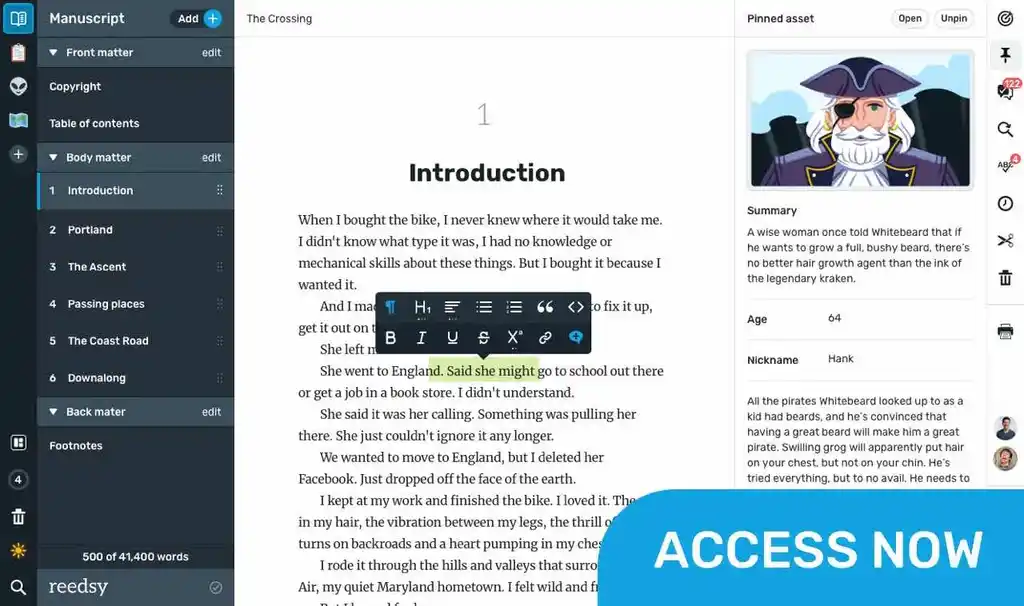



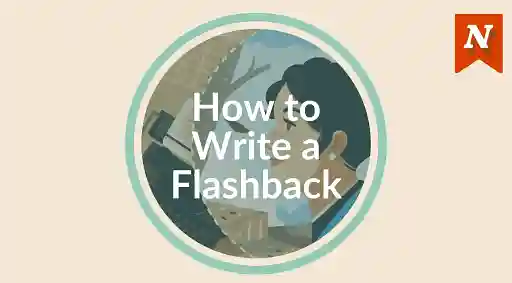
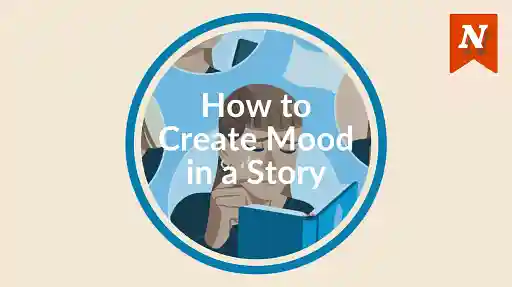
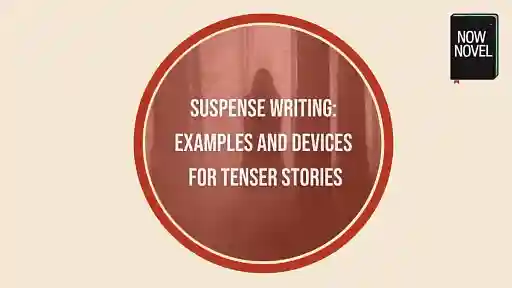

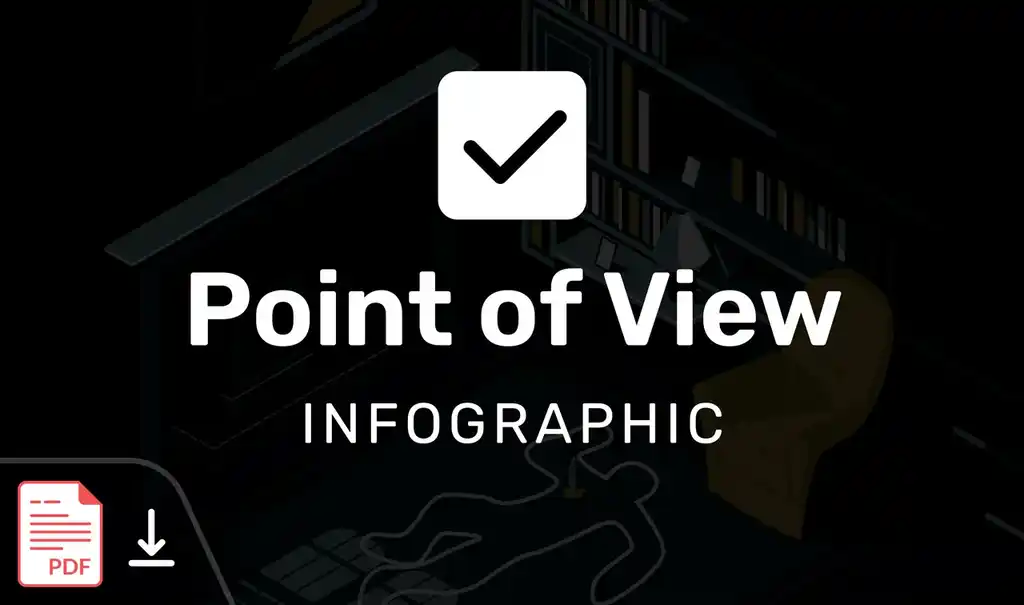
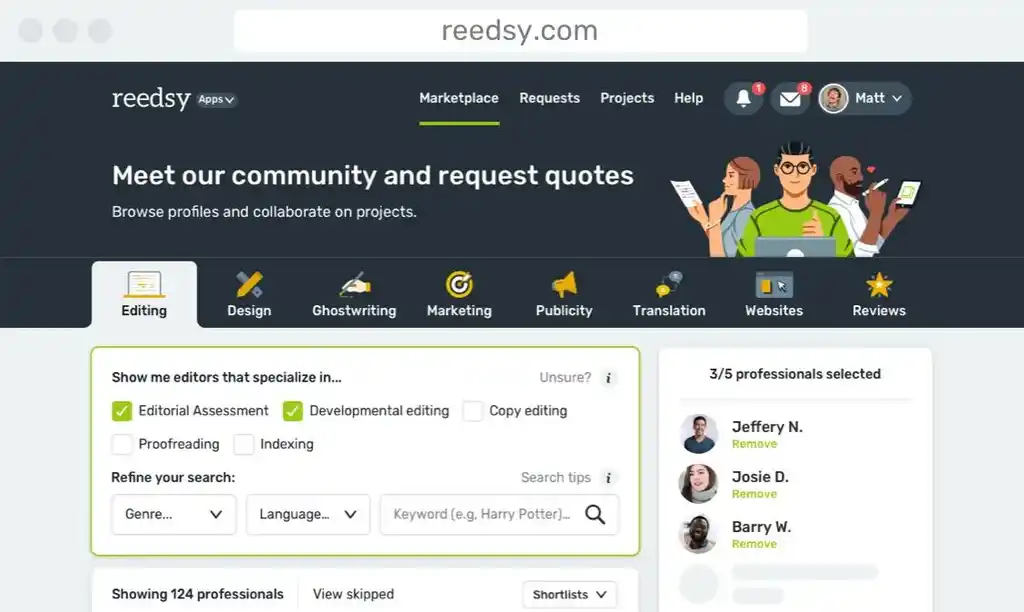
Very interesting and useful article :) just a thought, didn't Charlotte Bronte write Jane Eyre?
Pety Golja - Almost 10 years ago
Thank you, Pety. You're right, must have been a slip due to Austen and Bronte's protagonist having the same first name. It's been corrected, thanks for spotting that :)
Bridget At Now Novel - Almost 10 years ago
How can you be a proper omniscient narrator and not be mistaken for a limited third person narrator?
Sisa - About 9 years ago
Hi Sisa! While the third person limited only gives the reader access to the thoughts of whichever character is currently the focal/viewpoint character in a given passage, omniscient means that the reader knows every character's subjective feelings and experiences in a scene (it's not limited to one person). One way to make sure that your narration is truly omniscient is to describe multiple characters' opinions in a single scene, in such a way that it's not just one private inner world being shown.
Bridget At Now Novel - About 9 years ago
I'm trying to write my novella in the first person past tense… But although it's getting harder to keep from revealling things the character knows because of his timeline, and the reader finding out too much of the story to make it uninteresting. May go to seperate styles in each chapter instead… too much to think about, too many styles to try.
Homework Solver - Over 8 years ago
Because a novella's quite short it might be best not to jump around and use too many different POVs, but I'm sure you'll find a solution that works. Make a backup of your story and experiment with changing the POV until you find the one that feels best.
Bridget At Now Novel - Over 8 years ago
so im writing a novel....my first but, i cant figure out which narration to go off of....book revolves around 1 characters story...but i want to be able to express other characters feelings the same as the main characters feelings... basically i want to describe all the characters feelings......sorry if i dont make any sense im a total wreck at describing this
Dakota Bailey - Over 7 years ago
It would probably be best to go for a third person omniscient narrator-- they'd be able to "see" the thoughts of all the characters as well as describe the events around them. It's okay if the story revolves mainly around one person. Even when the focus shifts to other characters, the narrator would still be able to "see" inside of their heads. And even though they're omniscient, they can still leave out some details to keep the suspense going. Most importantly, don't worry about drawing the line between different types of narration! Use whichever qualities work best for you. As long as it's consistent, you're alright.
Blue Glass Hero - Over 7 years ago
Great Thanks!
Layne - Over 7 years ago
this was very helpful!!
Bryson Benton - About 7 years ago
This was very helpful for my school test.
Tyler Hassell - Over 6 years ago
yoo tyler
Damilola Okuwobi - Over 6 years ago
hi
Queen Stephanee - Almost 6 years ago
Hi QueenStephanee, how can I help?
Jordan At Now Novel - Almost 6 years ago
it was
Santos Johnson - Over 6 years ago
i´m writing a book that is on three sisters and i want to alternate between the three sisters but is also going to be told by a narrator. which point of view should i do?
Madison - Over 6 years ago
Hi Madison, thanks for your question :) It sounds as though you'd like to have multiple points of view, so you could do this by having each chapter told from a different character's viewpoint (one of the sisters), with the name of the sister currently telling the story as the chapter title (or a subtitle). This would make it clear to the reader who's currently telling the story. I'm not sure you'd need another narrator - how would they relate to the story? Are they a secondary character? I hope that helps. Good luck!
Jordan At Now Novel - Over 6 years ago
thanks! helped a lot!
Madison - About 6 years ago
I'm glad to hear that, Madison! Keep writing :)
Jordan At Now Novel - About 6 years ago
Glad to hear that! :)
Jordan At Now Novel - About 6 years ago
HELPED SO MUCH THANKSSSSSSSSSSSSSSSSSSSSSSSSSSS
Martin Tejeda - Over 5 years ago
hi i'm writing a book but i am having trouble its a horror story i just wanted to ask for tips or thing i should do
Lestat Gonzalez - Over 5 years ago
Hi Lestat, thanks for asking. We have an article here on horror that has tips: https://www.nownovel.com/blog/how-to-write-horror-story-tips/
Jordan At Now Novel - Over 5 years ago
thank you Jordan
Lestat Gonzalez - Over 5 years ago
My pleasure!
Jordan At Now Novel - Over 5 years ago
halp
Wolfi Chu - Over 5 years ago
Hi WolfiChu, what would you like help with?
Jordan At Now Novel - Over 5 years ago
Hello https://media3.giphy.com/media/YrZECW1GgBkqat6F0B/giphy.gif
Wolfi Chu - Over 5 years ago
hello peeps
Keegan Mouton - Over 5 years ago
how are you bryson?
Keegan Mouton - Over 5 years ago
Im making a story with more than one narrator, and im worried the readers might get confused. How should i make it clear whos narrating?
F Na F Maniac - Over 4 years ago
Hi there, Thank you for asking. One way to ensure clarity would be to have a new chapter or scene break each time the narrator switches and put their name as a heading. This way it is immediately clear to the reader who is telling the story. Faulkner does this in As I Lay Dying which has 15 narrators in total.
Jordan - Over 4 years ago
Thank you! This was very helpful!
Lindsay - Over 4 years ago
It's a pleasure, Lindsay. I'm glad to hear that! Thank you for reading our articles.
Jordan - Over 4 years ago
This was very helpful, coupling this information with this short video I've linked below really helped me with analysing "Neon Genesis Evangelion", Thanks!
Samuel Davis Hater99 - Over 4 years ago
Hi I am trying to learn about narrating and I cant pass the test do you know anything helpful I can use
Hiiiiiiiiiiiiiiiiiiiiiiiiiiii - Over 4 years ago
Hi there, what aspect of narrating is/was your test on? It's quite a broad subject!
Jordan - Over 4 years ago
I mean Point of veiw
Hiiiiiiiiiiiiiiiiiiiiiiiiiiiiiii - Over 4 years ago
hey, some of these things ive never heard of before, and i wanted to know, which is the BEST idea for these things to i don't know- make a story interesting?
Follow Me On Twitch.Tv/Coolturtle28 - Over 4 years ago
Hi there, thank you for your question. Do you mean which POV is the best to use? One isn't necessarily better than another, it depends on the context and the effect you're trying to achieve. For example, first person is useful for creating a sense of close intimacy with the narrator and is part of why it's typical for memoir/autobiography (though Roland Barthes wrote an autobiography in third person - there are no fixed rules other than the basic rules of grammar and such).
Jordan - Over 4 years ago
Great job
Kayla - About 4 years ago
There are only four of the six which are, first-person, second-person, third-person, and omniscient. that is correct.
Jasmine - About 4 years ago
Hi Jasmine, thank you for your feedback. There are in fact additional types of narrator, what you're referring to specifically is points of view with regard to person (Ursula K Le Guin differentiates between 'involved omniscient' narration, where the narrator knows what characters are thinking, and fly-on-the-wall which does not have access to any character's thought process but can only describe what a camera or fly-on-the-wall could see, hence the name). Thank you for reading our blog!
Jordan - About 4 years ago
Hi, could you share where Ursula K Le Guin shared her ideas on narrators? Much appreciated!
Nika - Almost 4 years ago
Hi Nika, with pleasure. It's a slim but excellent writing manual called Steering the Craft, which you can find on Goodreads here.
Jordan - Almost 4 years ago
hi I think your article was really true and I think the first person is very correct I mean I have seen many articles but this one is my favorite.
Nathan - Over 3 years ago
Hi Nathan, thank you for reading our blog and sharing your thoughts!
Jordan - Over 3 years ago
hi, your story was very interesting but there was one thing I didn't really get. The picture that showed the 6 types of narrator has something called a " Fly-on-wall"? And then it defines the word, but it didn't really define it that well. Can you explain it further?
Emily - Over 3 years ago
Hi Emily, thank you for sharing that and asking. A 'fly-on-the-wall' narrator you can think of as a security camera - it can only show what's happening, passively observing (but not pass judgment or evaluate, it has no persona/viewpoint/interpretation). So for example, a limited third person narrator might say: 'She shifted in her seat uncomfortably, dreading the interview'. A fly-on-the-wall narrator could only say 'She shifted in her seat' for the same sentence, not telling us any emotion directly that a character is feeling, as this narrative viewpoint cannot access what characters are feeling and thinking, only report the signs of these things (so this viewpoint relies heavily on inference and suggestion - on implying, for example, emotion through actions and movements and gestures). It is often referred to as an 'objective' viewpoint in contrast to 'subjective' (which, like first-person, is coloured by what the narrator thinks, feels, wants, likes, dislikes, etc.) I hope this helps!
Jordan - Over 3 years ago
Is that all the types of narration I am struggling with point of view.
Matthew - Over 3 years ago
Hi Matthew, perhaps not all, but I'm sure we can help. What aspect of POV are you struggling with? If you want feedback on narration or other aspects of your WIP, please do feel free to share it in our crit community on Now Novel that you have access to with a basic/free account. You'll find it a constructive group of writers of all ages and genre interests. Thanks for reading our blog.
Jordan - Over 3 years ago
this was really helpful
Ian - Over 3 years ago
Harry had taken up his place at St Paul School where he and his scar were famous but now the school year was over and he was back to the dursleys for the summer, back to being treated like a dog who had rolled in something smelly. The dursleys hadn't even remember that today happened to be Harry's 12 birthday. Of course, his Hopes hadn't been high they had never given him a real present, let alone a cake .... Please which type of narrators is this. I'm so confused
Emmanuel - About 3 years ago
Hi Emmanuel, this is third person limited. This means that characters are referred to in third person ('Harry had taken up his place') rather than first or second, and the limited means that the story and narration is filtered through Harry's own perspective - the reader can only know what Harry knows. 'Back to being treated like a dog who had rolled in something smelly' creates a sense of Harry's own thoughts about the way he's being treated by his aunt and uncle. In limited POV narration, the narration tends to be coloured by the viewpoint narrator's thoughts and feelings. I hope this helps!
Jordan - About 3 years ago
Hello! I'm writing a short story, and according to my friends who are reviewing it for me, I'm accidentally flip-flopping between narrative types (3 person limited and omniscient), and I'm not sure how to pick one and stick to it. Would you say it's accurate to describe Omniscient as 3rd person for all characters? Wouldn't omniscient be a form of 3rd person? The piece is historical fiction, and follows several lead historically accurate characters as well as cities and political events, many of which I want to be able to "explain" to my readers to really make them understand the demographic (which I think has to be the omniscient narrator), but I also want the narrator to be able to make biased comments... Like "he was called the 'the great' but he was the greatest fool' " or " I guess that's why they call it a circus". What feedback can you offer please?
Sarah - Almost 3 years ago
Hi Sarah, thank you for your great question. Omniscient does allow all characters' subjective experience, though you could technically have a first person narrator, like a God who knows everything, knows what every character is thinking/feeling. However it is much more common to have omniscient in third-person where a non-involved narrator (a narrator not involved in the story) tells the story moving freely between different characters' thoughts, feelings and experiences. The key difference between omniscient and limited is that in limited third-person, only what the viewpoint narrator knows, assumes, feels, understands may be shared, because it's as though the reader is seeing things through their eyes. Unless they're a mind reader, they can't know exactly what another character is thinking/feeling unless that person tells/shows them in some way. You could write this story as a multi-narrator story in third person, where each character's narration is in limited third person and any commentary is given by a character with a point of view (for example, if one narrator is a non-supporter of the character called 'the great', you might give them the line 'he was called 'the great' but he was the greatest fool'). Then if the leader has his own narrative point of view, he might just prattle on about how great he is. Omniscient would mean that either your narrator is involved in the story and knows everything, or is not involved in the story (like a fly on the wall) but knows everything. It is harder to do, though is a common viewpoint in older historical novels (e.g. Tolstoy). It is hard to pull off though. I'd strongly recommend Ursula K. Le Guin's writing manual, Steering the Craft as it has an excellent section on points of view. I hope this helps!
Jordan - Almost 3 years ago
Hi i was wondering if you could tell me if you can post more point of view things?
Kenzie - Over 2 years ago
Hi Kenzie, with pleasure. We have a complete guide to POV here, which I'm not sure whether you've seen? Thanks for reading our blog.
Jordan - Over 2 years ago
Good info
Saadullah - Over 2 years ago
slay
U - Over 2 years ago
All day :)
Jordan - Over 2 years ago
Slay what you want to slay let the slay slout
Diego - Over 2 years ago
Yass, Diego.
Jordan - Over 2 years ago
slay
Sperry - About 2 years ago
Hi Jordan can you help in portraying novel characters based on reality ..
Asia Iman - About 2 years ago
Hi Asia, I can do my best to, absolutely. What sort of help do you need with this? Off the top of my head, I'd say to change names and other pertinent details if they are living people whom you are basing characters on, so as to avoid any kind of issue with defamation etc. if any party dislikes how they're represented for any reason.
Jordan - About 2 years ago
I need to know about 3rd person limited and 3rd person omniscent
J Dawg#1 - About 2 years ago
Hi J Dawg, thank you for your question. What do you want to know about these POVs? Here's something I wrote on points of view, I hope it helps.
Jordan - About 2 years ago
HIIIIIIIIIIIIIIIIIIIIIIIIIII!!!!!!!!!!!!!!!!!!!!!!!!!!!!!!!!! I totoally don't know what I'm Doing! BUT THIS IS AWESOME!!!!!!!!!!!!!!!!!!!!!
Stephanie - Almost 2 years ago
Glad this is useful, Stephanie!
Arja Salafranca - Almost 2 years ago
I need help with points of view, please Jordan!
Wolfgirl - Over 1 year ago
Hello Wolfgirl, Thanks for writing in. What specifically do you need help with?
Arja Salafranca - Over 1 year ago
Hello Casey, how can I help? What specifically do you need help with?
Arja Salafranca - Over 1 year ago